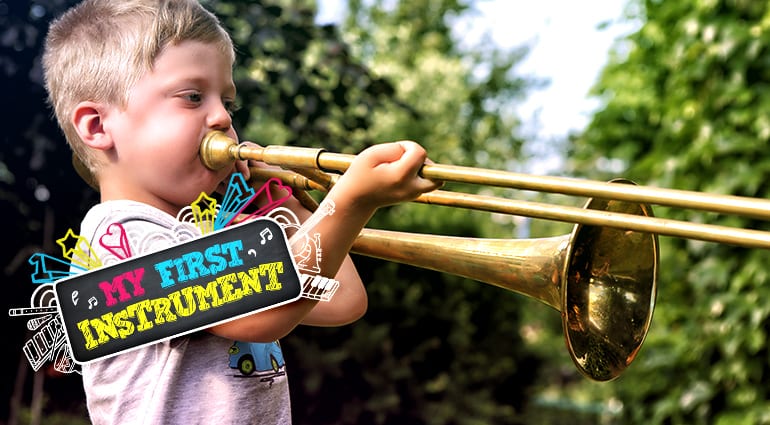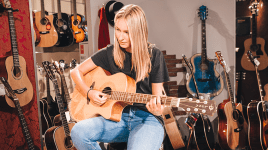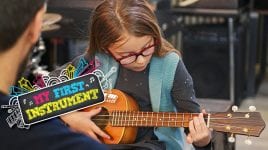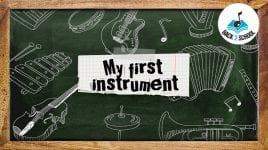
#MyFirstInstrument #MusicWasMyFirstLove
Your kids, or possibly you, have decided to learn an instrument. Excellent decision. Now think about what it could be, you could refer to our article about instrument categories if you need help. The next step, after putting one of the instrument candidates on your list, is to find the correct size or dimensions of it in relation to your body. It’s important for the beginner to play the instrument instead of fight with it! The good news is that many instruments come in a variety of sizes including child-friendly ones. Below, we show you some examples:
candidate No. 1 – the guitar
A super-popular instrument for beginners, in which models are offered in different sizes, is the guitar, especially the student or nylon-string guitar. Arm and finger length are the decisive factor here, so if we’re dealing with a child a size that is smaller than 4/4 is usually more appropriate. This is important for correct posture and with this in mind a young student might consider a 1/2-, 3/4– or 7/8-sized guitar. In case you’ve ever heard the term “female model” in reference to guitars this is usually the 7/8 size. It doesn’t mean this size is exclusively for women, some men might find it to be perfect for their body size. If the guitar is an intimidating option, maybe a ukulele might fit best right now?
- 1/2 size
- 3/4 size
- 7/8 size
- ukulele
candidate No. 2 – the flute
When it comes to wind instruments, you also face special requirements for age and height. A full-sized flute requires that the fingers must be spread wide, as long as the fingers and hands are not as full-grown as the flute itself. In addition, the length of the tube including the head piece is important, making the control and precision of certain tones demanding.
Of course, manufacturers have thought of this, a long time ago, and found solutions such as the curved head piece. These dimensions are undoubtedly easier to control. And at some point, the music students can retrain and readjust, easily, to a larger model.
candidate No. 3 – the accordion
The accordion is the traditional band-in-a-box! An instrument that asserts itself in different musical styles and is always up to date. However, it feels very bulky and heavy at first. Operating the bellows and playing on the bass and treble side at the same time requires some muscle! And an accordion with 42 keys on the treble side easily weighs around 12 kg. You have to lift weights first!
Well, kids don’t have to, after all, there are various different models, whereby size and weight are also determined by the number of keys in the treble, the basses and chords. You’ll even notice instruments specially designed for small beginners, paving the way for the next generation. The accordion is both a useful entry-level and popular advanced instrument, whether for the musette waltz, folk music or Irish rock.
candidate No. 4 – piano
A piano cannot be made smaller; at most there are slight deviations. Basically, the keyboard is largely standardised with regard to the size of the keys. This inevitably means that smaller students can hardly let off steam across the entire instrument. Those with long arms and fingers have an obvious advantage.
Your kids can certainly start with a smaller number of keys or slide wildly back and forth on the piano bench. At least there are alternatives with which the not-yet-fully-grown can prepare for the leap to the big piano, for example more compact e-pianos or small home keyboards with less keys. Please keep in mind, however, that smaller keys are only partially promising, especially since getting used to the standard size will be the real challenge.
candidate No. 5 – double bass
The double bass is undoubtedly an interesting instrument that can be a lot of fun. Whether it’s used as a string instrument in the classical world or plucked and slapped in a rockabilly, bluegrass or rock’n’roll context. The only problem is that the double bass is not very mobile, a musical monster some may say. Luckily, double basses are available in different sizes so that young musicians can also feel comfortable on the instrument. Check out some of the sizes below:
- 1/4 size
- 1/2 size
- 3/4 size (rockabilly style)
Let’s put it this way: Even if your kid really wants to learn something very special, you should remain realistic when making your choice. There are so many fun instruments; and the young musician eventually grows towards the full-sized ones. Don’t forget to check all of our Online Guides on thomann.de, they are a great resource for choosing the right instrument.
One comment
Leave a Reply
You are currently viewing a placeholder content from Facebook. To access the actual content, click the button below. Please note that doing so will share data with third-party providers.
More InformationYou are currently viewing a placeholder content from Instagram. To access the actual content, click the button below. Please note that doing so will share data with third-party providers.
More InformationYou are currently viewing a placeholder content from X. To access the actual content, click the button below. Please note that doing so will share data with third-party providers.
More Information


















William says:
Thanks for the great and very informative article also check :- Liszt Rhapsodie